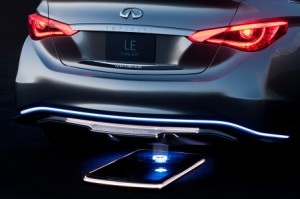By John Addison (5/31/12)
Electric vehicle wireless charging is now in use by electric cars, taxis, buses, car sharing, and racing teams. Is charging without plug connection in all of our future, or just special fleets?
Thousands of car sharing members are now driving electric cars. In San Diego, for example, over 6,000 members share some 200 Smart Electric Drive cars. After a car share member uses an electric car, however, they often forget to plug it in so that the next person can charge it. Now Hertz EV is experimenting with an easier approach – Wireless Electric Vehicle Charging (WEVC). Anticipating growing popularity, Sears Home Services is already partnering with Plugless Power to install systems for electric car owners.
Hertz, who provides both car sharing and car rental, is installing a Plugless Power inductive charge system. One charging plate will be installed in an EV parking space, the other at the bottom of the vehicle. Using the electromagnetics that we learned and forgot in high school, electricity is transferred through inches of air, charging the vehicles at 3.3 kW/hour.
Google and Duke Energy will also pilot wireless charging in their growing fleet of electric cars as part of the Apollo trial program launched by Evatran at the EBS 26 conference. The Nissan LEAF and the Chevrolet Volt are included in the Apollo program.
Wireless Charging’s Potential with Taxis and Buses
In Italy, over 30 buses on fixed routes in Genoa and Turin take advantage of wireless charging at bus stops to make electric transit a reality. The frequent charging allows these electric buses to save weight and thousands of dollars with smaller lithium battery packs.
We have all seen long lines of taxis at airports, hotels, and city centers. As it readies for the Olympics, the city of London will include a new wireless pilot program that includes Addison Lee taxis using Qualcomm Halo technology. The trial will involve a combination of passenger cars and light good vehicles and will be based partially in Tech City in the East of London, an initiative supported by the UK Prime Minister, David Cameron. Addison Lee has 3,500 minicabs and 250 chauffeur-driven luxury cars. Other partners include Chargemaster, Transport for London, and the Mayor of London’s office.
Qualcomm’s CDMA wireless technology is already in billions of mobile phones, e-book readers, and smart grid devices. It is significant that this communications giant is expanding into wireless charging. Qualcomm’s Anthony Thompson describes Qualcomm’s IntelliDrive Intelligent Mobility vision as including the following:
- Navigation services – ITS
- Safety and telematics
- Apps
- Content
- Payment
- Mobile hotspot
- Wireless Electric Vehicle Charging (WEVC)
Qualcomm’s wireless communications expertise will be valuable in shaping standards. It is important that wireless charging frequencies do not interfere with Wi-Fi, radio, and other communication frequencies. Industry standards in the 40kHz to 150kHz are desirable for 3kWh, 7kWh and 20kWh. Standards must include frequency in the communication spectrum, proximity, network topology and architecture.
Wireless Charging will be Standard with Infinity LE Electric Car
At the EV26 international conference, where I interviewed experts for this article, crowds were dazzled by the luxury Infinity LE, a beautiful sedan targeting to go on sale in two years. The Infinity all-electric car will include wireless charging, as well as standard Level 2 and DC Fast Charge (Chademo) connectors.
Evidently, Infinity part of the Renault-Nissan Alliance, is not concerned about frequent inductive charging affecting battery life. By making wireless charging standard on the Infinity LE, the Alliance may decide to make it standard on other electric cars including the Nissan LEAF and Renault Fluence.
BMW and Siemens have partnered to create wireless electric vehicle charging for the new BMW I electric cars. GM, Toyota, and others are evaluating the technology in the labs.
Dynamic charging in motion captures the imagination. Imagine driving an electric car with unlimited range along highways and with wireless charging embedded in the highway. HaloIPT in the U.K formed a partnership with Drayson Racing Technologies to test the technology on the track. In the next decade, we may see this on college campuses or even public streets.
WEVC technology providers are optimistic about achieving 90% efficiency. Still, there is the potential for significant energy loss. Safety concerns must be fully addressed. People don’t want their pet cat to be in the middle of a wireless charge. Since, charging only occurs when devices are paired, unobstructed, and communicating, safety fears are likely to be overblown. A mass consumer market would require significant infrastructure investment.
Wireless charging is not new. It is available for a wide range of consumer electronics including mobile phones, game electronic games, and iPads. Heat, inefficiency, and lack of industry standards have all discouraged wide use. But according to a new report from Pike Research, the market for wireless power systems – encompassing mobile devices, consumer electronics, industrial applications, infrastructure devices, and electric vehicles – will triple over the next 8 years, growing from $4.9 billion in revenue in 2012 to $15.1 billion in 2020.
Wireless EV charging has attracted giants such as Qualcomm, Siemens, Delphi, Renault-Nissan, BMW, Hertz, Google, Duke Energy and a number of innovative smaller companies. Wireless EV Charging (WEVC) may prove to be a great fleet application, even if it fails to catch-on with most consumers, or WEVC may be the future of electric vehicle charging.
(Disclosure: Author owns stock in QUALCOMM and Siemens.)


Is there a translation available for the previous comment??? The concept of “broadcast” energy has been considered sci-fi for decades… Perhaps this system is representative of “baby steps” toward our future. We can only hope!